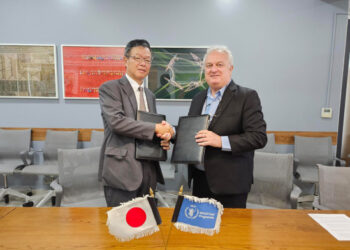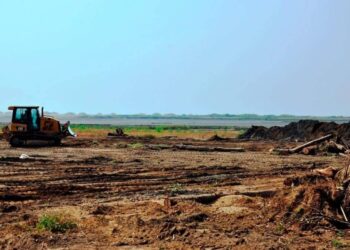If the exit of the Rohingyas from the Rakhine state in Myanmar under state persecution of the Muslim minority, fanned by fundamentalist Buddhist nationalism, is acclaimed a “textbook example of ethnic cleansing;” the current hazardous circumstances of the Rohingya refugees in refugee camps in Cox’s Bazar, Bangladesh is still no beacon of hope for human security and dignity. The denial of citizenship – the ‘state of statelessness’ over generations, institutionalized state violence by the Tatmadaw and radicalized Buddhist sects began the Rohingya genocide out in August 2017. With an estimated 745,000 Rohingya refugees fleeing across the Bangladesh border into the Chittagong Hill tracts, Bangladesh provided them refuge, primarily hosting them in the Kutupalong and Nayapara refugee camps in the Cox’s Bazar area. The “most persecuted minority in the world,” is housed in the largest refugee camps in the world, reaching an estimate of a million refugees, as of 2024. As Cox’s Bazaar became one of the densest areas in Bangladesh, since 2021, nearly 30,000 refugees have been relocated from the 33 camps in Cox’s Bazar to Bhasan Char Island by the Government of Bangladesh.
Humanitarian and climate refugees
Yet, the Rohingya refugees face compounding insecurities. Almost 95% of Rohingya households in Bangladesh rely on humanitarian assistance for daily survival without any sustainable sources of livelihood. Rohingya refugees lack legal status, and their movements outside the camps are restricted, leaving them entirely dependent on humanitarian assistance. This makes them vulnerable to exploitation and abuse. More than 75% of the refugee population are women and children, with over half of the refugees in the camps are under the age of 18, facing acute food and water, physical and material insecurities, limited opportunities for education and livelihood. These are the minorities within minorities.
The Rohingyas are match both classes of humanitarian and climate refugees. Cyclone Mocha struck in May 2023, causing widespread destruction in Bangladesh and Myanmar. It was the most severe storm in recent years, impacting 2.3 million people in Bangladesh, including 930,000 Rohingya refugees. The Monsoon season in Bangladesh (June to October) brings heavy rainfall and strong winds to Bangladesh, increasing the risk of floods and landslides. Rohingya refugees live in flimsy shelters made of bamboo and tarp, built in areas vulnerable to landslides, which may not withstand the heavy rains and winds – threatening loss of life and shelter. The rainy season also exacerbates the risk of diseases such as hepatitis, malaria, dengue, and chikungunya, especially in crowded camps with inadequate water and sanitation facilities, putting children and the elderly at higher risk. Both the Cox’s Bazaar camps and the Bhasan Char Island camp sits at the mouth of the Bengal delta, which has been detrimentally impacted by the global climate crisis, whereby, the rising sea level has hampered coastal economies, with the Bangladesh monsoon, that is scattered with tropical cyclones, creating greater vulnerability for an already marginalized community.
Securitization
The South Asia region is an active generator of refugees, but South Asian states have steered clear of accepting formal responsibilities in addressing refugees, with only Afghanistan being a curious signatory to the 1951 Refugee Convention. South Asian states have sought a more voluntary approach to taking in refugees, with geopolitical considerations driving the select acceptability of refugee communities.
While the South Asian states securitize, local politics has often scapegoated refugee populations, turning majority insecurities into electoral capital – a fear that refugees’ encroach on physical and political spaces, jobs, land, corner welfare resources meted out by the state and place undue pressures on infrastructure; a case in point the rhetoric against Rohingya refugees in Bangladesh. While initial bonhomie over the Islamic fraternity was seen as the Sheik Hasina government’s solidarity, the long-term presence of Rohingya refugees has led to a shift in sentiment, with locals viewing them as a threat and expressing frustration over the aid they receive, leading to tensions and resentment.
Dependency and political turmoil
The dependency on the Bangladeshi state for sustenance and security has left the Rohingyas at mercy of the government. While Bangladesh, under international law had provided refuge to the Rohingyas. Overtime, the rapid and sizable influx of Rohingya refugees now outnumbers locals nearly three to one in the two sub-districts, Ukhiya and Teknaf. While this has aggravated the locals, the growing political turmoil in Bangladesh, especially post-Hasina, has left the refugees with a sense of moral and material abandonment. Rohingya refugees are risking their lives by attempting to cross dangerous sea routes to Indonesia and Malaysia, which are among the deadliest in the world. In 2023, one Rohingya died or went missing for every eight who attempted this journey.
Moreover, the 2024 Bangladesh crisis has marked the re-defining of national identity in Bangladesh, a final break away from Mujibur’s legacy of the secular imagination of the Bangladeshi nation. Even as the Nobel laureate, Muhammad Yunus, leads the nation following Sheikh Hasina’s resignation and flight, Bangladesh’s interim government has moved to lift the ban on the Jamaat-e-Islami party that had been imposed under antiterrorism laws indicating a mainstreaming of radical Islamist groups. While the Rohingyas may not face religious persecution, with 91 percent of the country identifying as Sunni Muslim, and a sustained Islamization of the Bangladesh. Bangladesh redefined as a country for Bengali-Muslims also leaves out the considerable number of own tribal groups, including the Buddhist hill tribes of Chittagong (Chakmas, Hojongs, etc.). Here the politicization of refugees by locals as cause for their grievances may lead to what Das and Simon call ‘conspicuous identity,’ in “Identity in Manipur: A South Asian model of conflict” in Frontier realities: A deep dive into Northeast India’s ethnicity, geopolitics, and security edited by K. Verma, D. Dwivedi, & P. Das, that may lead to prolonged ethnic violence by snowballing of identities and scapegoating of minorities.
Intersectional governance
The 2017 emergency in the Rohingya context has become protracted, requiring comprehensive and periodic information about the evolving needs and vulnerabilities of affected refugee and host communities. Therefore, is a need for intersectional governance for human security and climate action.
This can be understood by borrowing from intersectional feminists: in terms of interlocking axis of suppression by Patricia Hill Collins, as well as countermobilization. In the camps, men are largely unemployed and dependent on humanitarian aid, while women have taken on productive roles such as cash-for-work programs, NGO volunteers, and community leaders. The focus on empowering women and girls in humanitarian programs, often excluding men, has led to backlash and tensions within households and communities, especially when men feel unable to fulfill their traditional role as breadwinners. The changes in gender roles have led to feelings of powerlessness among men, contributing to violent behavior, which also increases women’s vulnerability to sexual and gender-based violence. On top of this, the refugee crisis has restricted women’s mobility despite attempts to promote women’s participation in community processes, as they are viewed as the symbolic bearers of religious and ethnic identity.
An intersectional approach to the climate and humanitarian Rohingya refugees would allow for a more socio-culturally sensitized set of measures, considering the compounding vulnerabilities and capacities, any definite intervention should be designed with an understanding of the differential impacts on men, women, minors and individuals with diverse identities, ensuring that specific needs are met without making vulnerable groups more exposed, with adequate analysis of material and physical assets, social and organizational capacities, and psycho-social strength.
There is need for humanitarian actors to effectively analyze the power dynamics and the intersectionality of the refugee category with other factors like disability, sex, age, etc. in planning and programming. This creates a situation of compounding vulnerabilities for the Rohingyas in the Cox’s Bazaar refugee camps, who are faced with (1) statelessness, (2) migration, (3) climate crisis, (4) securitization and pollicization in Bangladesh, (5) political turmoil, and all of these aggravated by (6) gender subordination, etc. By incorporating more participatory methodologies, one can empower communities to take an active role in their development, ensuring that their voices are heard and their needs are met in a more inclusive and responsive manner, securing multidimensional capability-building for all stakeholder communities (refugees plus host community). Therefore, an intersectional approach to understanding policy impact on all stakeholders must form the praxis in addressing the refugee and climate crisis in the global south.



















